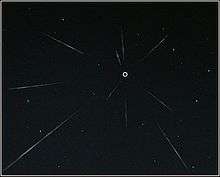Radiant (meteor shower)
The radiant or apparent radiant of a meteor shower is the point in the sky, from which (to a planetary observer) meteors appear to originate.[1] The Perseids, for example, are meteors which appear to come from a point within the constellation of Perseus.
An observer might see such a meteor anywhere in the sky but the direction of motion, when traced back, will point to the radiant. A meteor that does not point back to the known radiant for a given shower is known as a sporadic and is not considered part of that shower.
Many showers have a radiant point that changes position during the interval when it appears. For example, the radiant point for the Delta Aurigids drifts by more than a degree per night.[2]
Cause
Meteor showers are mostly caused by the trails of dust and debris left in the wake of a comet. This dust continues to move along the comet's wake, and when the Earth moves through such debris, a meteor shower results. Because all of the debris is moving in roughly the same direction, the meteors which strike the atmosphere all "point" back to the direction of the comet's path.
As an exception, the Geminids are a shower caused by the object 3200 Phaethon,[3] which is thought to be a Palladian asteroid.[4]
Observation

The radiant is an important factor in observation. If the radiant point is at or below the horizon, then few if any meteors will be observed. This is because the atmosphere shields the Earth from most of the debris, and only those meteors which happen to be travelling exactly (or very near) tangential to the Earth's surface will be viewable.
References
- ↑ Earth Observatory Glossary: Radiant on NASA.gov
- ↑ Lunsford, Robert (2008), Meteors and How to Observe Them, Astronomers' Observing Guides, Springer, p. 86, ISBN 0387094601
- ↑ Brian G. Marsden (1983-10-25). "IAUC 3881: 1983 TB AND THE GEMINID METEORS; 1983 SA; KR Aur". International Astronomical Union Circular. Retrieved 2011-07-05.
- ↑ "Exploding Clays Drive Geminids Sky Show?", 2010 October 12